wdswan@erols.com
Dear all, The Zoroastrian textile was the subject of a TurkoTek show and
tell within the past year. For a full discussion of similar textiles, I
refer all to Asian Art, the second Hali annual, in which Patricia L. Baker
shows various examples of Zoroastrian costumes. Some are located at
Hampton Court Palace in Surrey and were collected by Sir Percy Molesworth
Sykes while he was British counsel in Kerman between 1895 and 1903. Most
of the very few Zoroastrians remaining in Persia are located around Yazd,
near Kerman. The textile which I presented at the potpourri is
appoximately 5 feet wide and about 18 inches high. It is made entirely of
silk and has extremely fine botehs embroidered on it. It is quite
difficult to see just how fine the work is without magnification. Each
strip is about 2 inches wide. 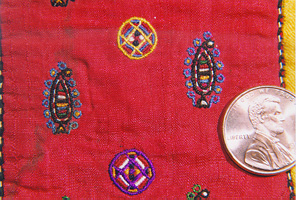 The strips are separately dyed (to an incredible saturation) and
then sewn together and onto a blue cotton backing. The embroidery extends
through that backing. The individual botehs mirror in their stripes the
stripes of the full textile. Here is the full panel. The strips are separately dyed (to an incredible saturation) and
then sewn together and onto a blue cotton backing. The embroidery extends
through that backing. The individual botehs mirror in their stripes the
stripes of the full textile. Here is the full panel. 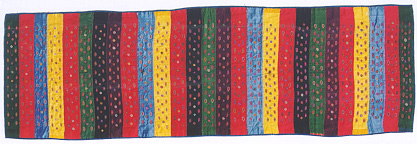 Although it is hard to imagine
that something five feet long was made to encircle the lower leg of a
bride, that is the case. These strips form part of the “baggy” or
“voluminous” trousers that the brides wear. Below is an image of the full
trousers, the top portion of which is not seen beneath other layers of
clothing. Although it is hard to imagine
that something five feet long was made to encircle the lower leg of a
bride, that is the case. These strips form part of the “baggy” or
“voluminous” trousers that the brides wear. Below is an image of the full
trousers, the top portion of which is not seen beneath other layers of
clothing. 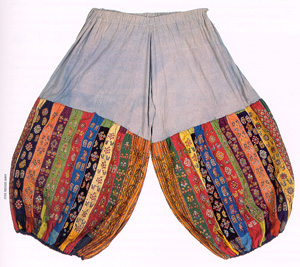 Following is
an image of a Zoroastrian woman wearing a Zoroastrian costume of
headdress, shawl, jacket, tunic and the baggy trousers. Following is
an image of a Zoroastrian woman wearing a Zoroastrian costume of
headdress, shawl, jacket, tunic and the baggy trousers. 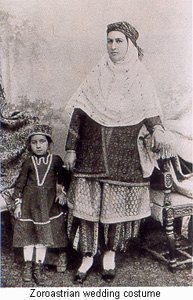 Traditionally, the Zoroastrian
men wore virtually unadorned garments, in strong contrast to the colorful
costumes of the women. Elsewhere in this salon, the subject of the harmony
of natural dyes was mentioned. There are many who may find the array of
colors and patterns of the entire costume to be disharmonious, clashing or
confusing. While I normally prefer patterning to be offset by plain space,
there is also something appealing to me about the riot of colors in these
costumes and the aesthetic which those colors represent. Individually,
this panel has a combination of strong, simple colors and intricate
details. I am probably more attracted by the simple stripes than I am by
the embroidery, but, at least for me, this is an example of what “color”
is all about. Best, Wendel Traditionally, the Zoroastrian
men wore virtually unadorned garments, in strong contrast to the colorful
costumes of the women. Elsewhere in this salon, the subject of the harmony
of natural dyes was mentioned. There are many who may find the array of
colors and patterns of the entire costume to be disharmonious, clashing or
confusing. While I normally prefer patterning to be offset by plain space,
there is also something appealing to me about the riot of colors in these
costumes and the aesthetic which those colors represent. Individually,
this panel has a combination of strong, simple colors and intricate
details. I am probably more attracted by the simple stripes than I am by
the embroidery, but, at least for me, this is an example of what “color”
is all about. Best, Wendel |
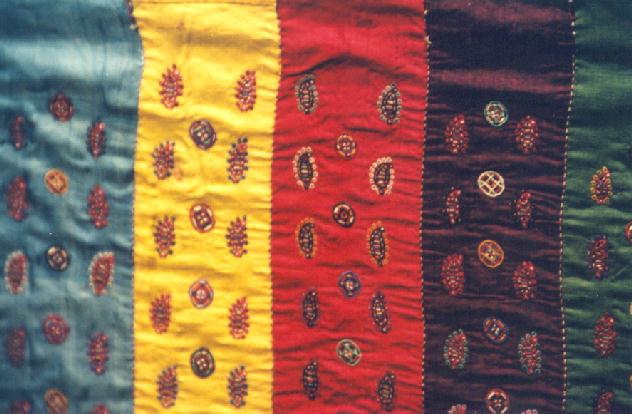 Perhaps I
really only want to call attention again to the beauty of this textile but
I do have a question to ask about it. Wendel, could you talk a little of
what you know of the basis for its attribution as "Zoroastrian?" I assume
the major auction house described it in these terms. Did they indicate
something of their rationale? And while we are looking at it, did we say
anything about its likely use? Regards, R. John Howe
Perhaps I
really only want to call attention again to the beauty of this textile but
I do have a question to ask about it. Wendel, could you talk a little of
what you know of the basis for its attribution as "Zoroastrian?" I assume
the major auction house described it in these terms. Did they indicate
something of their rationale? And while we are looking at it, did we say
anything about its likely use? Regards, R. John Howe The strips are separately dyed (to an incredible saturation) and
then sewn together and onto a blue cotton backing. The embroidery extends
through that backing. The individual botehs mirror in their stripes the
stripes of the full textile. Here is the full panel.
The strips are separately dyed (to an incredible saturation) and
then sewn together and onto a blue cotton backing. The embroidery extends
through that backing. The individual botehs mirror in their stripes the
stripes of the full textile. Here is the full panel.  Although it is hard to imagine
that something five feet long was made to encircle the lower leg of a
bride, that is the case. These strips form part of the “baggy” or
“voluminous” trousers that the brides wear. Below is an image of the full
trousers, the top portion of which is not seen beneath other layers of
clothing.
Although it is hard to imagine
that something five feet long was made to encircle the lower leg of a
bride, that is the case. These strips form part of the “baggy” or
“voluminous” trousers that the brides wear. Below is an image of the full
trousers, the top portion of which is not seen beneath other layers of
clothing.  Following is
an image of a Zoroastrian woman wearing a Zoroastrian costume of
headdress, shawl, jacket, tunic and the baggy trousers.
Following is
an image of a Zoroastrian woman wearing a Zoroastrian costume of
headdress, shawl, jacket, tunic and the baggy trousers.  Traditionally, the Zoroastrian
men wore virtually unadorned garments, in strong contrast to the colorful
costumes of the women. Elsewhere in this salon, the subject of the harmony
of natural dyes was mentioned. There are many who may find the array of
colors and patterns of the entire costume to be disharmonious, clashing or
confusing. While I normally prefer patterning to be offset by plain space,
there is also something appealing to me about the riot of colors in these
costumes and the aesthetic which those colors represent. Individually,
this panel has a combination of strong, simple colors and intricate
details. I am probably more attracted by the simple stripes than I am by
the embroidery, but, at least for me, this is an example of what “color”
is all about. Best, Wendel
Traditionally, the Zoroastrian
men wore virtually unadorned garments, in strong contrast to the colorful
costumes of the women. Elsewhere in this salon, the subject of the harmony
of natural dyes was mentioned. There are many who may find the array of
colors and patterns of the entire costume to be disharmonious, clashing or
confusing. While I normally prefer patterning to be offset by plain space,
there is also something appealing to me about the riot of colors in these
costumes and the aesthetic which those colors represent. Individually,
this panel has a combination of strong, simple colors and intricate
details. I am probably more attracted by the simple stripes than I am by
the embroidery, but, at least for me, this is an example of what “color”
is all about. Best, Wendel